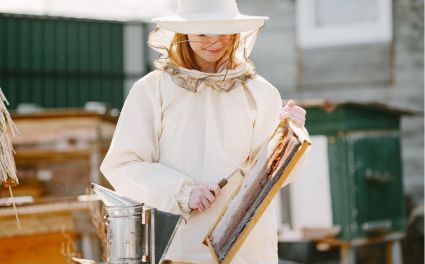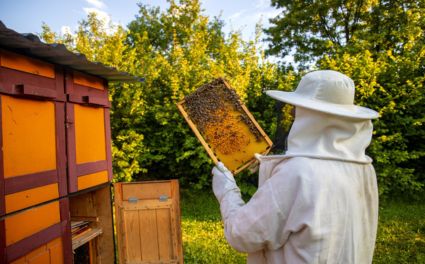When we think of bees, we often picture them buzzing from flower to flower, collecting nectar and pollen. But behind this simple act lies one of nature’s most remarkable achievements — the construction of their home: the beehive. A hive is not just a shelter; it’s a living, breathing structure designed with precision, purpose, and teamwork. In this blog, we’ll take a closer look at how bees make hives, exploring each step in this natural masterpiece and highlighting the essential role that beekeeping and protective gears play in supporting healthy colonies.
🏠 The Hive: Nature’s Perfect Shelter
A beehive serves as the heart of a colony. It’s where bees live, work, raise their young, and store food. Every cell, wall, and layer inside the hive is a product of thousands of coordinated efforts by worker bees.
Let’s explore how bees build their homes — step by step.
🐝 Step 1: Choosing the Perfect Location
Before construction begins, bees must find a safe and suitable site for their new home. Wild colonies often select tree hollows, rock crevices, or sheltered areas, while managed bees live in wooden hive boxes provided by beekeepers.
The chosen location must protect the colony from harsh weather, predators, and moisture while remaining close to flowers for foraging. Beekeepers, wearing protective beekeeping suits and beekeeping veils, often guide hive placement in optimal spots where bees can thrive peacefully.

🧱 Step 2: Gathering Building Materials
Once a site is found, bees gather materials to begin construction. The two main substances they use are beeswax and propolis.
-
Beeswax is produced by worker bees through special glands on their abdomen. They secrete wax flakes, chew them, and mold them into shape.
-
Propolis, sometimes called “bee glue,” is collected from tree resin and plant sap. It’s sticky and strong, helping seal cracks and strengthen hive walls.
Beekeepers working near active colonies often wear beekeeping gloves and beekeeping trousers to safely handle frames without disturbing this delicate process.
🧩 Step 3: Building the Comb
The comb is the most iconic part of any hive. It’s composed of hexagonal beeswax cells that act as both storage units and nurseries.
Why hexagons?
Because they’re mathematically perfect. This shape allows bees to use the least amount of wax while maximising strength and storage space — an incredible example of nature’s engineering.
As worker bees secrete wax, they form perfectly aligned hexagons suspended vertically inside the hive. In managed colonies, beekeepers insert frames with foundation sheets to help guide bees in building straight, uniform combs.
Brands like OZ Armour emphasise the importance of professional hive management, encouraging beekeepers to use proper tools and protective gear — including beekeeping jackets and beekeeping ankle protection — to maintain hive safety while inspecting comb development.
🍯 Step 4: Honey Storage and Production
One of the comb’s most important functions is honey storage.
Bees collect nectar from flowers and bring it back to the hive, where worker bees deposit it into the wax cells. Then, through a remarkable process, they fan their wings to evaporate moisture from the nectar, transforming it into thick, golden honey.
Once ready, bees seal each cell with a thin layer of wax — preserving the honey for later use, especially during colder months.
Beekeepers carefully extract honey without harming the bees or the comb structure, ensuring a continuous cycle of production and sustainability.
🐣 Step 5: Brood Rearing
The hive isn’t just for honey — it’s also a nursery.
The queen bee lays eggs in specific cells, which are then cared for by worker bees. The hive’s temperature is maintained around 35°C, ideal for larval development. Worker bees regulate heat by fanning their wings and clustering together when it’s cold.
This perfect environmental balance shows how bees use teamwork and body coordination to ensure colony survival. In managed hives, beekeepers wear beekeeping suits and beekeeping veils during inspections to monitor brood health without disrupting the bees.
🛡️ Step 6: Hive Defense
Bees are fiercely protective of their home. The hive’s entrance is guarded by worker bees, who inspect incoming bees to prevent intruders.
The comb structure itself acts as a defensive barrier, keeping pests away from brood and honey. To deter invaders and strengthen the hive’s interior, bees use propolis — sealing every crack or gap.
For beekeepers, safety during hive inspections is paramount. Using professional gear like beekeeping jackets, beekeeping gloves, and beekeeping ankle protection provides reliable protection from stings while ensuring bees remain calm.
🧴 Step 7: Propolis Reinforcement
Propolis is more than just glue — it’s a natural antibiotic. Bees coat the hive interior with a thin layer of propolis, sterilising the environment and keeping out bacteria and fungi.
This natural sanitisation process is one of the reasons why hive interiors are among the cleanest environments in nature. It also shows how bees instinctively practice hygiene long before humans studied it.
🔄 Step 8: Comb Expansion and Maintenance
Beehives are dynamic — constantly expanding, repairing, and adapting. During spring and summer, colonies grow rapidly, prompting bees to build new comb layers.
Older combs that become dark or brittle are replaced with fresh wax structures. In managed hives, beekeepers rotate frames to maintain cleanliness and productivity.
To prevent contamination or disturbance during this process, professionals use ventilated beekeeping suits or lightweight beekeeping jackets for comfort during longer sessions.
💬 Step 9: Hive Communication
Inside the hive, communication is everything. Bees use pheromones and vibrations transmitted through the comb to share information.
This system allows them to coordinate tasks like foraging, brood care, and temperature regulation. The hive operates as a single organism — each bee playing its role in perfect synchrony.
👩🌾 The Beehive: A Collective Effort
Every hive is the result of teamwork among thousands of worker bees. From wax production to comb construction, honey storage, and defense — each bee contributes to the colony’s success.
Beekeepers play a supportive role by providing structured hives and maintaining healthy colonies. To safely manage inspections or honey harvests, they rely on quality protective clothing such as beekeeping trousers, beekeeping gloves, and beekeeping veils.
Young learners and family beekeepers often use beekeeping kids suits, ensuring safety for children while they experience the wonders of beekeeping.
🧠 How OZ Armour Supports Beekeepers
Beekeeping requires patience, skill, and the right gear. OZ Armour, a trusted name in professional beekeeping equipment, focuses on designing protective clothing that allows beekeepers to work confidently around active hives.
Their range — including ventilated suits, poly-cotton jackets, and reinforced gloves — is built for durability, breathability, and protection. By supporting safe hive management, OZ Armour helps beekeepers maintain strong, thriving colonies while reducing stress on the bees.

🌿 Final Thoughts
The process of hive construction is one of nature’s most extraordinary marvels — a blend of instinct, architecture, and community. Bees build not just homes but entire ecosystems that support plant life, agriculture, and biodiversity.
Understanding how bees make hives deepens our respect for these tiny architects and highlights the importance of sustainable beekeeping. With reliable protective gear like beekeeping suits and beekeeping jackets, beekeepers can safely manage colonies and protect the very creatures that help sustain our planet.
To learn more about bees, honey production, and hive care, visit the Beekeeping Blog to read more blogs about beekeeping and explore insights on sustainable practices and modern beekeeping gear.



